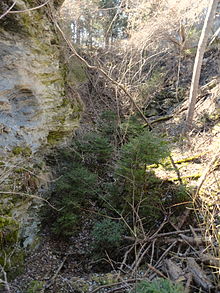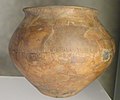Cresta settlement
The Cresta settlement ( German "Hügelsiedlung" ) is a crevice on the Heinzenberg near Cazis in the Swiss canton of Graubünden that was inhabited for a long time during the Bronze Age (2300–800 BC) . The place is included in the list of cultural assets of national importance in the canton of Graubünden .
Discovery and Location
The Heinzenberg is a mountain range that has been repeatedly broken up by the erosion of torrents. One of its northernmost spurs is the Cresta, the plateau of which lies south of Cazis 70-100 meters above the valley floor. In 1942, the district forester Walo Burkart carried out an initial archaeological survey on the plateau and found it. The results showed that the site had enormous potential. The several meters thick stratigraphy required several months of excavation campaigns under the direction of Emil Vogt , which extended over 24 years. The evaluation of the rich finds is ongoing.
On the plateau of the hill there are two five to eight meter wide, ravine-like crevices that the first settlers chose as living places more than 4000 years ago. Adapted to this topography, the settlement was laid out as a single row village. The length of the column provided space for eleven houses, in which an average of 30–50 people lived. The topography of the place meant that the successive villages had to be built like a plate on the rubble of the previous settlement. The result was a mighty stratigraphy that documents about 1500 years. The good conservation conditions thanks to its location in the crevice make Cazis-Cresta an important site in the Alpine region.
The villagers had a view of the valley from the hill plateau. The Cresta settlement was on the one hand at the starting point of the north-south Alpine passes San Bernardino , Splügen and Julier and on the other hand it offered connections to the east. For the inhabitants of the Cresta, the trade routes meant contacts and exchanges that took place with the north, south and east. The Terramare ceramics found from the early Bronze Age refer to the early ascent of the passes.
Animal bones
Like other archaeological finds, the animal remains recovered in Cazis-Cresta ended up as waste in the ground during the Bronze Age. The 300,000 bone fragments contain information about animal species, skeletal elements, fragment parts, gender, individual age, anomalies and pathologies, preservation, animal damage, signs of processing, burns and slaughter, weight and size. Statistical analysis provides insights into areas of everyday life for residents. The huge amount of bones left by farm animals is evidence of life that was shaped by agriculture and livestock. The hunt hardly played a role.
Reshaping the livestock industry during the Bronze Age
Meaning of domestic animals
Because of its body mass, cattle already covered most of the meat requirements on the Cresta in the early Bronze Age, but the herd size was somewhat smaller than that of the sheep and goats. With an average and relatively constant share of eleven percent, the pig was the third most important pet. The early Bronze Age livestock farming in the Cresta settlement was therefore mainly (90%) and roughly evenly geared towards cattle and sheep / goats. Dog remains are found in small numbers.
From the Middle Bronze Age onwards, the importance of cattle grew, they became the most important domestic animals. Up until the Late Bronze Age, their share in the spectrum of animal species rose continuously from 45% to 67%. The sheep / goats also fell behind, as pig breeding remained constant.
Use of pets
During the “Early Bronze Age”, around 30% old cattle (older than six years) and young calves are represented in the bone material of the Spaltensiedlung. So young animals were also eaten more often. The relatively small proportion of animals over six years old suggests that the villagers were primarily interested in meat, while the secondary use of the living animal, such as B. Milk and labor played a subordinate role.
With sheep / goats, too, the age groups in which the ratio between yield (amount of meat) and investment (feeding expenditure) promises an optimal yield are represented with over 60%. The sheep / goats (33%) were also still staple food during the "Middle Bronze Age". In addition, the coat - and possibly the milk - was probably used. The use of pigs was even more one-sided than the meat yield. More than two thirds of them were slaughtered to the young adult stage. From the slaughter age analyzes it can be seen that the proportion of old cattle increased from the Middle Bronze Age to the same extent as the proportion of younger calves decreased. This trend continued in the "Late Bronze Age", so that at the end of the epoch almost 50% old cattle were compared to a good 10% younger calves. The changes in the age profile indicate a growing importance of secondary use as work animals and milk producers. The increased occurrence of joint wear (osteoarthritis of the hip joint) in cows and (albeit less) oxen from the Middle Bronze Age confirms these results. Similarly, the continuous increase in the number of old sheep / goats suggests an increased turn to the use of living animals (coat, milk) at the expense of the meat industry. Similar tendencies can be observed in settlements in the Eastern Alps, such as in South Tyrol (Naturns-Schnalserhof, Sotciastel, Nössing).
Development of size of the pig
Until the end of the Early Bronze Age, the pig bones convey a uniform picture of the size and growth of the animals. They were of medium stature. During the Middle Bronze Age, the proportion of pigs with a stocky, strong build increased. At the same time, the decline in the petite pigs can be observed. Are the stocky pigs crossbred from wild boars? If one assumes that the farmers from the Spaltendorf deliberately allowed or even forced a mixture in order to get more robust animals (refreshment of the genetic material), it is interesting whether they have adopted this knowledge. When comparing measurement data for pork bones from stations in the Middle Bronze Age in the Alpine region and in the neighboring lowlands, it was shown that the eastern Alpine region is the main source of influence from outside.
Importance of wildlife
The highest proportion of wild animals in bone material is around 4% in the initial phases of the settlement. This is not unusual for a mountain village at that time, but very little compared to the Swiss plateau, where the proportion of hunting animals fluctuated between 15 and 30%. The importance of hunting continuously decreased during the Early Bronze Age. The diverse composition of species is striking (bear, deer, ibex, wild boar, wolf, wild cat, various bird species). Meat-rich species seemed to be preferred, which at the same time required the least possible hunting effort; There is no evidence of deer or chamois. Trophies like fur, wings, claws, teeth etc. probably also had a meaning. The low proportion of hunting can be explained by the fact that no prolonged emergency situations gave rise to intensive hunting and the residents of Cazis-Cresta could rely on their agricultural production.
With the beginning of the Middle Bronze Age, not only the frequency but also the species diversity of wild animals decreased significantly: the farmers from Cazis now went hunting even less than in previous epochs. From the Late Bronze Age onwards, wildlife finds are limited to wild boars, which in view of the possible damage to the fields may have been a protective hunt.
The Petrus Hill on the same mountain slope as the Cresta settlement north of Cazis was already inhabited in the Neolithic .
See also
literature
- Petra Plüss: The Bronze Age settlement Cresta near Cazis (GR). The animal bones , Chronos, 2011.
- Stefanie Jacomet: Cazis-Cresta: a prehistoric settlement above the Rhine Valley , 1978.
Individual evidence
- ↑ The joint estimate is made because the two types cannot always be separated on the bone material.
Web links
- Animal bone examination (PDF; 7.0 MB)
Coordinates: 46 ° 42 '36.2 " N , 9 ° 25' 53.5" E ; CH1903: 752 375 / 175139



